
With post-pandemic ridership at around 80-85% of pre-pandemic levels, around 1.7 million of the 5 million daily journeys in London are made using pay as you go with contactless. Around 70 per cent of all pay as you go journeys on buses are made using contactless payment cards or mobile devices.
Andrew Anderson, Head of Customer Payments at TfL, said: “We’re delighted to be celebrating the 10-year anniversary of contactless payment on buses. The introduction of contactless was an important moment for TfL and it is incredible how fast the last ten years have flown by. From humble beginnings, it has transformed the way our customers travel and is now the most popular way to pay as they travel in London. It signified a real step forward in how we have made our customers’ journeys easier and more convenient than ever before, positioning TfL globally as an innovator and inspiring other transport networks to follow in our footsteps.”

